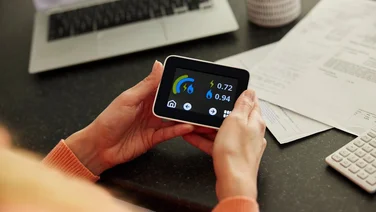✔ Growing produce at home can save you hundreds of pounds per year
✔ It’s a completely sustainable process
✔ 55% of UK adults want to grow more of their food
Looking to live a little greener but don’t want to pay the high price of something like solar panel costs? You could try growing your own food.
The glorious truth is that anyone can grow their own food, without spending too much, in practically any amount of space.
Maybe you want to produce a consistent stream of meals for you and your loved ones. Maybe you love the idea of growing your own delectable chilli peppers, or maybe you’d just like to turn any food waste you have into compost.
Whatever your circumstances, you can produce tasty, freshly grown food that’s in season, and help the planet in the process.
You won’t be alone either, as the majority of UK adults want to grow more of their own food, according to Statista. So let’s dive in, and help you to ensure your crops survive and thrive.
How to start growing your own food
Follow these simple steps, and you’ll be eating fresh, garden-to-table food in no time, complete with a sweet sense of accomplishment.
Watch this space
The first step is to assess your space, and decide where you want your plants to live and grow.
This may be a section of your garden, a plot in your local allotment, or a windowsill in your kitchen – you can tailor food-growing to your life and goals, so the choice is up to you.
What do you want to grow?
With your chosen space in mind, pick which plants you’d like to nurture to fruition.
You can pick from three categories: herbs, fruits (including nuts), and vegetables.
Make sure to either match your crops to your garden’s soil, or buy new soil for the plants you want to grow.
And this may sound obvious, but buy crops you enjoy eating. That way, you can celebrate a bountiful harvest with a hearty meal.
If you’d like to start off slow, you can get partially grown plant plugs, settle them into a pot or your garden, and see how it feels to help them fulfil their potential – kind of like babysitting before you have a child of your own.
Also make sure to choose a variety of crops that you can harvest at different times of the year. This will help keep you motivated, and teach you how to grow a diverse group of foods.
Get organised
Next, make a calendar for your plants. Research each of your crops, and plan out their life cycles.
Make notes reminding you when to plant, water, prune, and harvest different crops, and you’ll be well on your way to becoming a successful home food producer.
Grow your own food in your garden
If you’re lucky enough to have access to a garden where you can plant and harvest crops, then you’re in for a world of hard-won gratification.
Our main piece of advice is to look into the specific needs of your crops, but we have some general tips that will help you to get started.
Firstly, make sure to protect your crops.
Many plants are vulnerable to frost, and animals like birds and insects. Place a polythene covering over these crops, to keep the heat in and the pests out.
A fine mesh covering won’t protect your crops against the cold, though it will at least keep insects out.
If you’re worried about cats interfering with your home food project, use chicken wire. Any kitties in the local area will steer well clear.
Secondly, water your crops regularly, but do so either in the early morning or early evening.
This isn’t because of the myth that you’ll burn your plants by watering them in the midday sun, but because less of the water will evaporate, making the process more efficient and eco-friendly.
Lastly, when you harvest your crops, be aware that it’s not an exact science. Some plants have to be taken up as soon as they’re ripe, while others are more laid back.
If you want to work out whether a crop is ready or not, use the sense that matters when it comes to food: taste.
What types of food can I grow in the garden?
55% of the food eaten in the UK is made right here, according to government data, which shows the enormous variety of options available to you.
The Royal Horticultural Society lists 56 vegetables, and that’s not even getting into the dozens of fruits and herbs you can grow.
From apples to watercress, pumpkins to potatoes, rocket to rhubarb – it’s all possible if you take the right measures, and anyone can do it.
If you’d like to grow more exotic crops like sweet potatoes or cocoa beans, it’s possible, but not without a large plot of land and an expensive greenhouse.
If you’re ever in that situation, and you have the required expertise, then anything is possible. You can grow everything from tea and coffee to papayas, coconuts, and mangoes. Go (grow some) bananas!
Grow your own food indoors
Growing food inside is more challenging, especially as you usually have less space and a lower tolerance of soil getting everywhere – but it’s totally possible, and equally rewarding.
What types of food can I grow indoors?
Plenty! You can grow fruits, vegetables, and herbs inside – you just have to be careful and creative.
For vegetables like carrots, radishes, and spring onions, make sure that their containers have big enough holes to let them drain properly, and provide each crop with enough soil.
Carrots, for instance, only need 2cm of soil depth, while tomatoes need at least 30cm of soil depth and width to expand into.
Choose a potting mix to grow your plants in, rather than garden soil, as this should ensure better drainage.
Also, consider whether your home will provide your crops with enough natural lighting. If not, buying extra lighting is easy and affordable.
If you’d like to welcome the gorgeous scent of fruit trees into your home, you have a plethora of options. Go down the citrus route with a lemon, lime, or orange tree, or grow a tree bearing apricots, peaches, or figs.
You can develop any of these fruits from seeds, or buy a shrub if you don’t possess years of patience.
Tasty, freshly grown herbs are also well within your grasp. Just plant them in a pot on your window sill, and as long as you water them and they get their required 12-16 hours of sunlight, you should be all set.
You can also use hanging baskets to create more space inside, in a way that shouldn’t bother you or anyone you’re living with.
Is it cheaper to grow your own food?
Absolutely. Growing your own fruits, vegetables, and herbs can save you a significant amount of money every year.
For the cost of a few seeds, or just by using food scraps, you can grow produce which costs dozens of pounds at your local supermarket – and the sky’s the limit.
Just think of all the money you spend on produce every year, and then consider crops like rhubarb, swiss chard, apples, pears, plums, and every other plant that needs minimal care for it to produce free food every year.
Sometimes your crops won’t come good, and you’ll be short a cabbage or two – after all, even expert gardeners get it wrong occasionally – and trying to feed yourself entirely on homegrown food will get tricky.
But in general, it’s a fantastic way to save money.
Is growing your own food sustainable?
Growing your own food is one of the most sustainable actions you can take.
The cycle is endless: you can use scraps from foods like potatoes, onions, and lettuce to grow new produce, and then use scraps from those items to create even more homegrown food.
This process cuts down on food waste, as any unwanted food can be replanted or turned into compost, and avoids the numerous polluting acts that supermarkets carry out to get food to you.
When you’re growing your own food, there’s no wrapping produce in plastic, no carbon emissions from driving or flying it thousands of miles, and no harmful pesticides.
It’s one of the quickest ways to help the planet – and its results are delicious.






